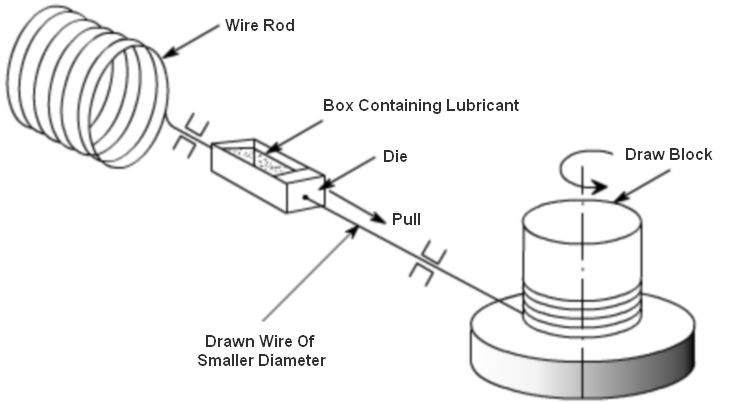
Wire Drawing
The usage of drawn wire is far beyond from everyday products like electrical wire & TV cables as well as paper clips and staples. It is used greatly in making springs of all kinds used in garage doors and other high tensile applications as well for making re-bar used in construction world-wide. Even spokes on wheels, metal handles & wire brushes are all manufactured from wire. Literally speaking, the usage of wire is beyond man-count and to satisfy this insatiable need millions of miles of wire is continuously drawn by wire-mills annually.
Science Behind the Wire Drawing
The process of wire-drawing has not changed over years and still it uses combination of dies to draw wire of the particular gauge size desired. Owing to huge demand, wire-drawing has always remained a very cost-sensitive as well as a competitive market. Wire drawing is basically a metal working process wherein the cross section of wire is reduced by pulling it through a series of dies keeping the volume intact. This process is a type of forging wherein permanent change of metal shape occurs keeping volume intact. It can be carried out in hot, warm or cold temperature. When wire drawing is carried at room temperature, it is referred as ‘Cold worked’ forged. Here, the wire only changes shape and its other characteristics remain intact.
The Wire Drawing Process
The process of wire-drawing is very simple and initiates by placing the coil of wire rod at beginning of machine on a spool. To start the process the end of wire-rod is first cut or flattened little to feed it through machine. Then, Pulling-in-Dogs are used to drag the inlet wire around drawing blocks of machine, until there is an adequate ‘wraps’ of wire around blocks for the machine to continue feeding automatically. Later, it is passed through series of dies to achieve the final cross sectional area desired. At the end of machine is a coiler which rolls the wire into a coil. The end process can sometimes be carried using a barrel and coiled wire is spooled directly into the barrel using a turntable. When desired tonnage of wire is achieved the wire rod is cut with the help of cutters.
If multiple dies are used for achieving the final wire-size then they are arranged serially keeping into note that the tension and speed of wire is continuous as it travels through machine to achieve a consistent cross section. Also, care has to be taken to maintain machine temperature due to heat released while deforming of metal. Accordingly, water system can be introduced which continuously baths the drums cooling them. Also, air blower system can be used to blow cool air on the drums keeping the machine temperature down.
Challenges of the wire drawing application include:
- Little downtime.
- High speed involved can cause large amounts of scrap thereby lost revenue if any process issue occurs.
- High torque & related speed control
- Fast process times thereby being economical.
- Different speed ranges as well as torque levels based on material being drawn.
Numerous materials can be used for drawing wire including mild steel, stainless steel, high-carbon, copper depending on the end-user requirement. Mild steel wire is used greatly in metal nails formation whereas high-carbon wire is used greatly in spring-steel applications.
Bharat Industries has an experience of nearly 40 years in providing wire-drawing dies as well as accessories including cutters,pulling-in-dogs. Please feel free to approach for your requirements and be rest assured to get the best services in Thane!
This entry was posted on Sunday, November 10th, 2013 at 8:24 pm and is belong to category Blog.




